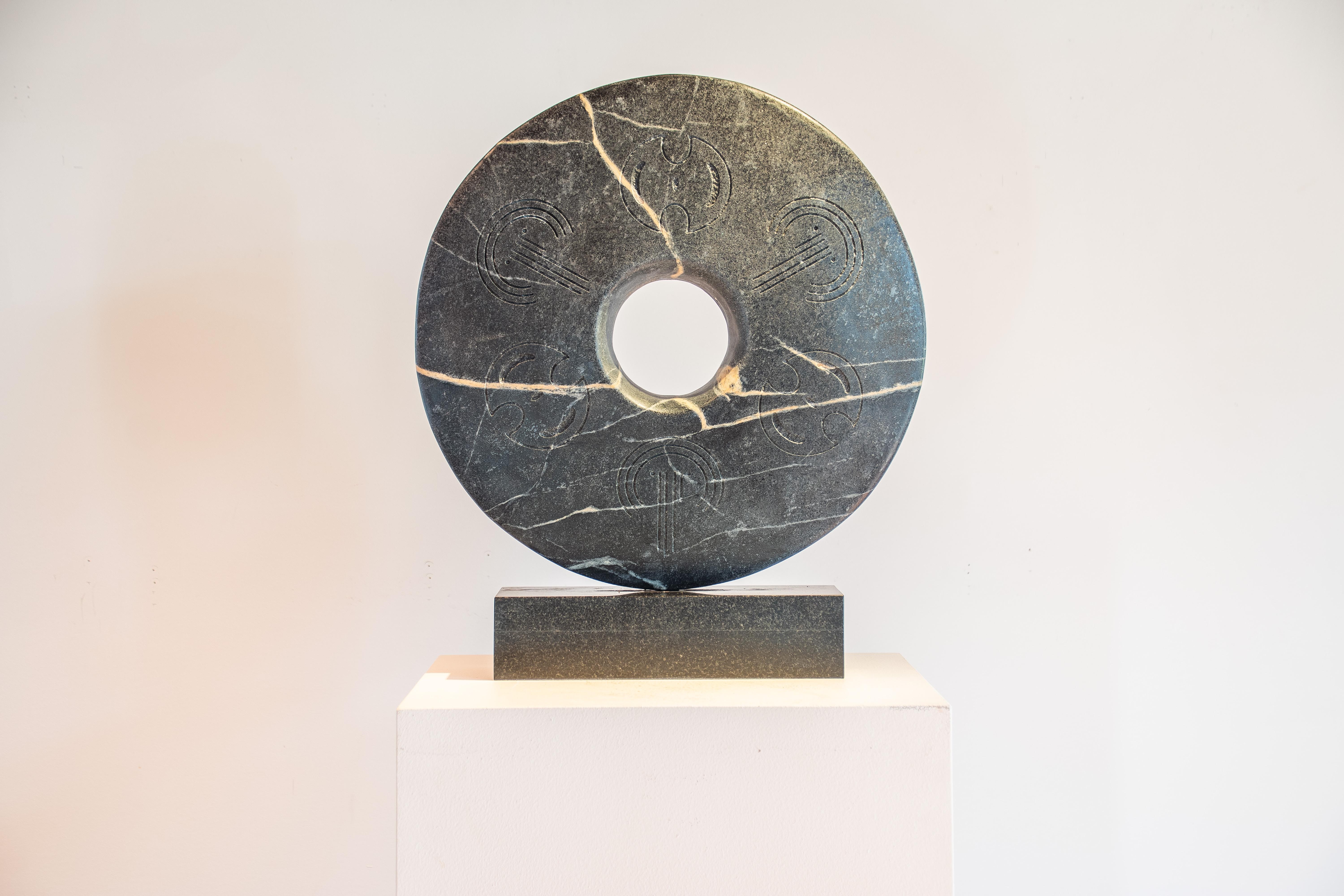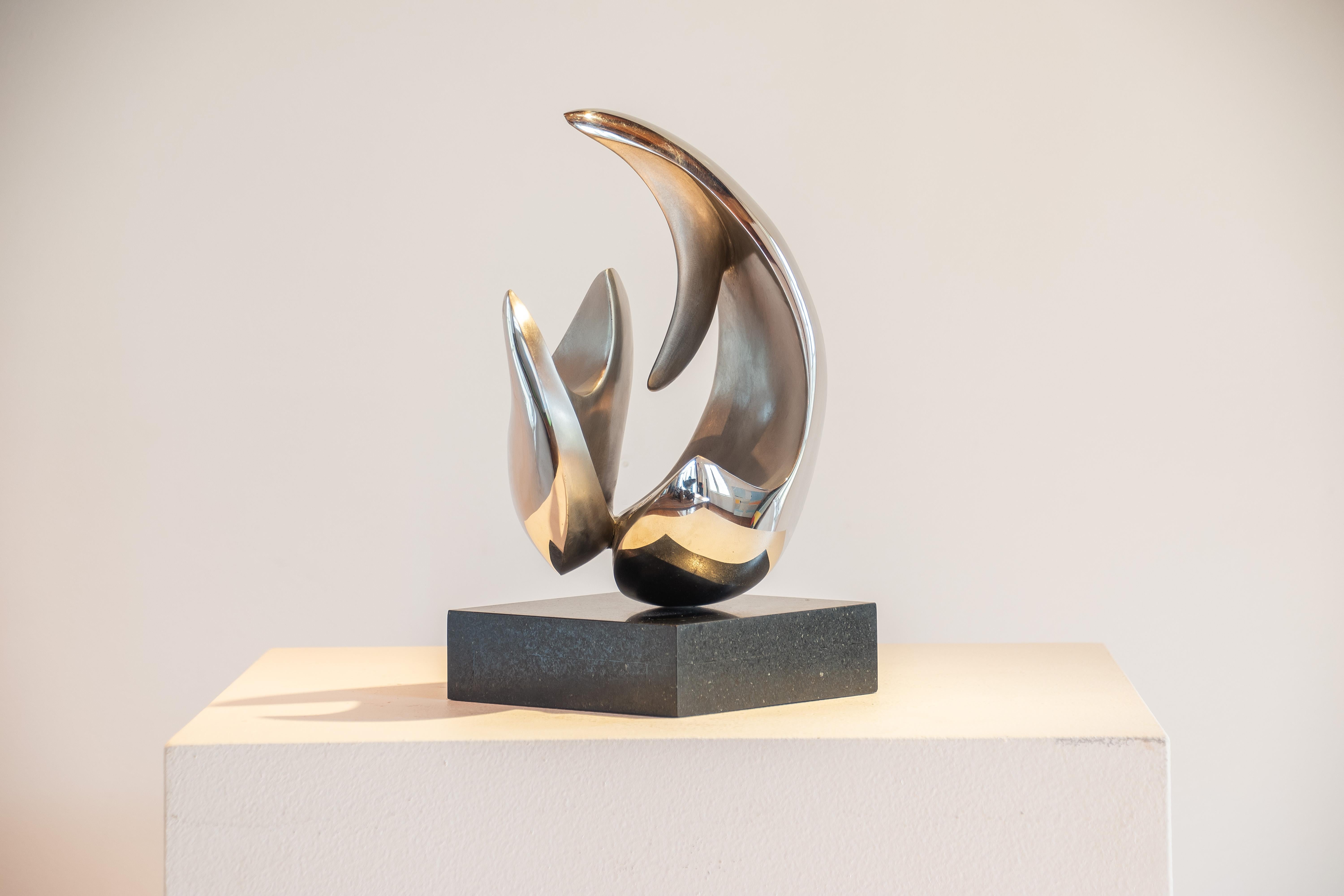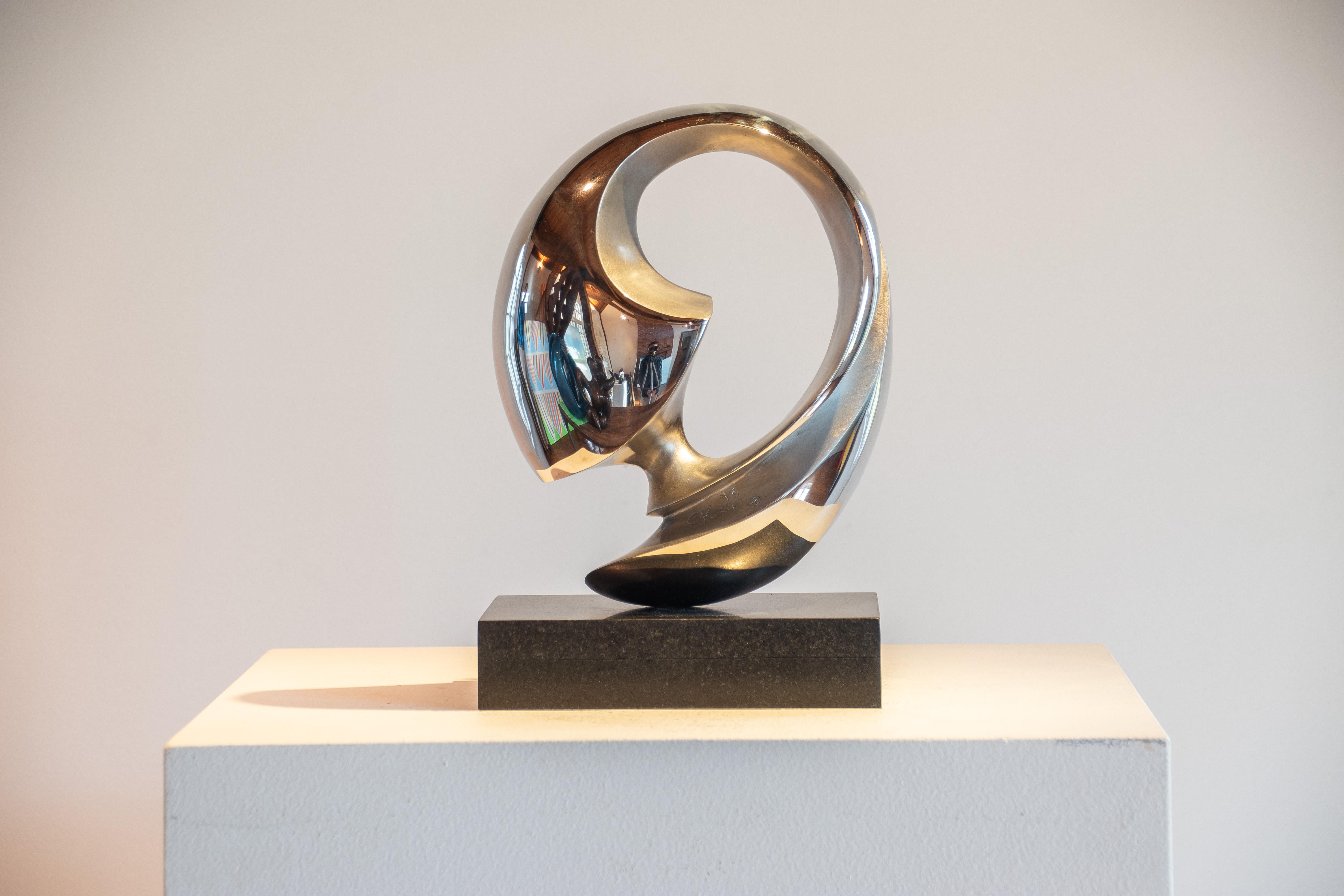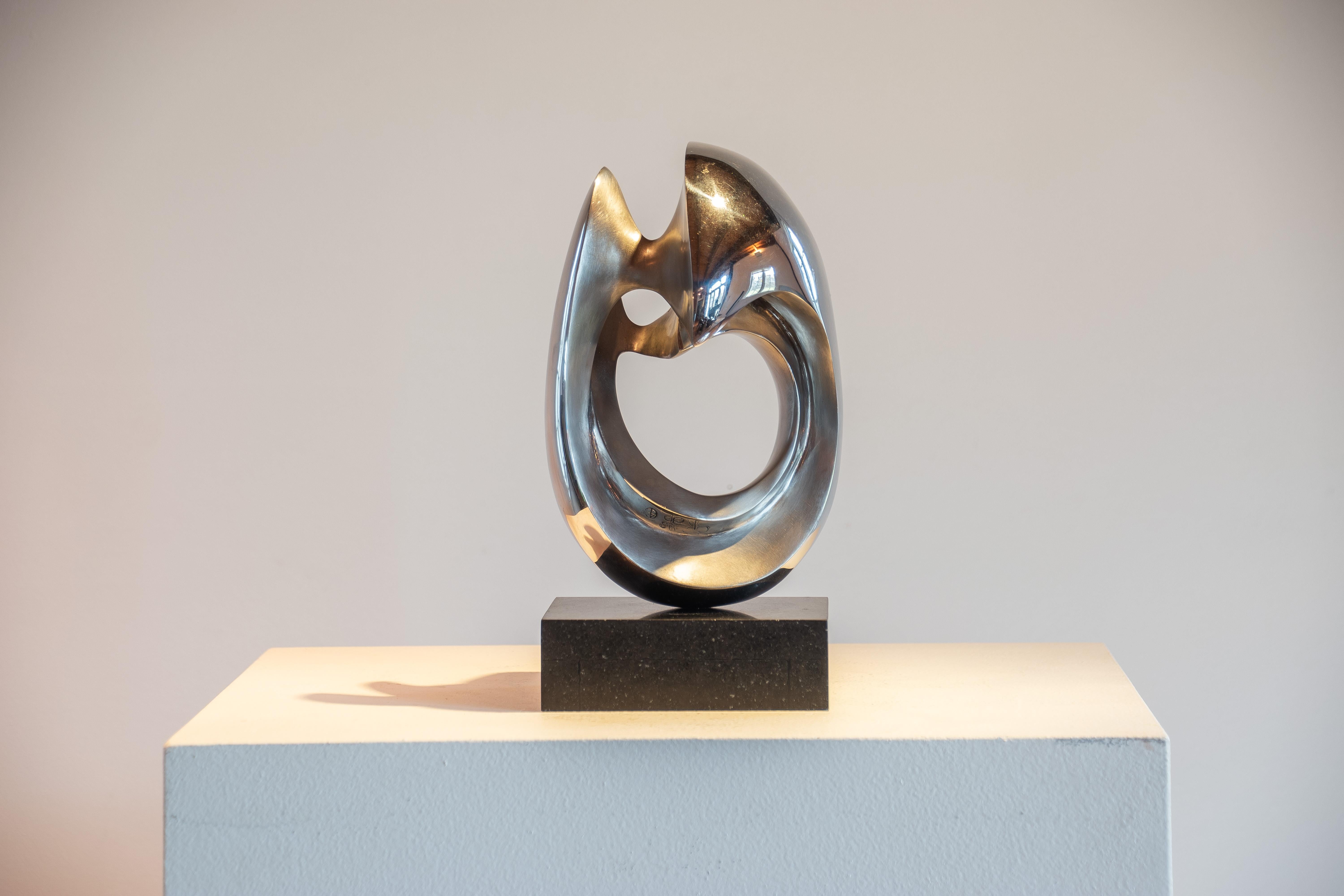Items Similar to 'Chicken' original Shona stone sculpture signed by Samuel Likongwe
Want more images or videos?
Request additional images or videos from the seller
1 of 6
Samuel Likongwe'Chicken' original Shona stone sculpture signed by Samuel Likongwe2002
2002
About the Item
'Chicken' is an original opal serpentine sculpture signed by the Zimbbwean artist Samuel Likongwe. Based in Harare, Likongwe was trained in the Shona stone sculpting tradition and his style consistently shows a careful ordering of the nonuniformity of the stone. The chicken is constructed of rectilinear forms with right angles, but together the forms curve into the U-shape of the chicken's body. The use of texture of the bodies is ingenious, using a series of textured parallel lines to suggest the ruffle and regularity of well-preened feathers. At the same time, areas of the stone are left rough-hewn, emphasizing the material of the stone and its origins in the quarry. The overall effect, with this tension between the artist's genius and the stone material itself, reminds of the sculptures of Constantine Brancusi: 'The Kiss' (1907) likewise applies stylized figure to the rectilinear form of the stone block, which marked an important shift in Modern sculpture that still resonates with sculptors today.
opal stone (serpentine)
signed "Samuel Likongwe" along bottom of sculpture, proper left
mounted to a rusticated concrete base
15 x 10.5 x 8 inches, sculpture
2.25 x 8.88 x 8.88 inches, base
17.25 x 10.5 x 10 inches, overall
Excellent overall condition with no signs of wear or damage
Shona artists and crafts people have been working in different media for generations. These include paintings, pottery, basket ware, wood carvings, and sculpture done in metal as well as the stone carvings. While there is not a long standing tradition of sculpture in what is now Zimbabwe (formerly Southern Rhodesia), stone carvings dating from the 15th century were seen in Great Zimbabwe, an excavated temple near Bulawayo. Most of the artifacts from this location have been moved to museums in Cape Town, South Africa or London.
It is generally agreed that Zimbabwean stone sculpture as seen today began during the late colonial period of the 1950's and 1960's. During this period the artists and artisans depicted many of the traditional Shona and other tribal spiritual myths.
Out of all the nations in Africa, the large varieties and abundant supplies of rock formations present throughout the Zimbabwe landscape provide artists with a medium for sculpture and carvings unique to their country. The Shona art sculpture of Zimbabwe combines the wonderful varieties presented by the stone with images drawn both from reality and abstract symbolism.
Much of the stone used by Shona artists is quarried in areas which are adjacent or quite near the villages where the work is created. Often the land on which the stone is found is owned by the village or the local artists. The artists use stone such as Serpentine (somewhat old, having been formed about 2.6 billion years ago), with more than 200 color variations. The hardest and darkest of the Serpentine varieties is black, commonly known as Springstone or Africa stone. Less seen is Lepidolite, with its beautiful pale mauve coloration; and the very hard Verdite, found mostly in darker shades of green but with other variations as well.
Commonly referred to as Rapoko stone in Zimbabwe, Steatite is a natural soft stone that falls under the general category of soapstone. Rapoko is found on every continent in the world with the possible exception of Antarctica. Its remarkable qualities have made this stone one of the most widely used minerals on earth. Over 10 million years old, Rapoko is a natural mineral, prized since ancient times for its durability, workability, beautiful character and ability to retain and radiate heat and resist chemicals. Native cultures, the world over, have carved Rapoko/Steatite into vessels, art objects, memorial and cultural items. Carved items have been found in the tombs of Pharaohs, in the igloos of the far north, in temples and palaces of China and India, in the mountains and river valleys of the Americas and the arid plains of Africa. There is a manmade ceramic product, also called Steatite, which uses the natural Rapoko stone as one of its raw materials but has no other connection to the skillful efforts of talented Shona and other African artists.
The wonderful natural character of stone is used both in its rough cut and textured state, or heated and burnished to a high gloss to reveal rich greens, browns, blacks and grays. The hardness, shape, density and quantity used of serpentine, verdite, sandstone, granite, steatite and other stones define the ultimate presentation of completed Shona art sculptures and carvings.
- Creator:
- Creation Year:2002
- Dimensions:Height: 17 in (43.18 cm)Width: 10.25 in (26.04 cm)Depth: 10 in (25.4 cm)
- Medium:
- Movement & Style:
- Period:
- Condition:Excellent overall condition with no signs of wear or damage.
- Gallery Location:Milwaukee, WI
- Reference Number:
About the Seller
4.9
Platinum Seller
These expertly vetted sellers are 1stDibs' most experienced sellers and are rated highest by our customers.
Established in 1966
1stDibs seller since 2017
392 sales on 1stDibs
Typical response time: 2 hours
- ShippingRetrieving quote...Ships From: Milwaukee, WI
- Return PolicyA return for this item may be initiated within 14 days of delivery.
More From This SellerView All
- 'Face' original signed cobalt stone Shona sculpture by Obert MukumbiBy Obert MukumbiLocated in Milwaukee, WI'Face' is an original cobalt sculpture by the Zimbabwean artist Obert Mukumbi. This sculpture demonstrates the artist's influence from the great Shona...Category
Early 2000s Contemporary Figurative Sculptures
MaterialsStone
- 'Coming From the Fields' original Shona stone sculpture by Colleen MadamombeBy Colleen MadamombeLocated in Milwaukee, WI'Coming From the Fields' is an original black serpentine sculpture by the celebrated second generation Shona artist Colleen Madamombe. The sculpture presents a character common to Ma...Category
Early 2000s Contemporary Figurative Sculptures
MaterialsStone
- 'Mother Elephant with Baby' original small sculpture, heirloom giftLocated in Milwaukee, WIThis small and intimate sculpture of a mother and infant elephant is a heartfelt and doting example of the sculpture of the Shona artists of Zimbabwe...Category
Late 20th Century Contemporary Figurative Sculptures
MaterialsStone
- African Female Figure Stone Sculpture Contemporary Shona Expressionism SignedBy Colleen MadamombeLocated in Milwaukee, WI"Morning Excercise (C-3)" is an original black serpentine stone sculpture by Colleen Madamombe. The artist signed the piece along the base of the skirt. This artwork features a woman...Category
Early 2000s Contemporary Figurative Sculptures
MaterialsStone
- Africa Female Artist Stone Sculpture Figure Celebrate Modern Contemporary SignedBy Colleen MadamombeLocated in Milwaukee, WI"Celebrations (C-56)" is an original black serpentine stone sculpture by Colleen Madamombe. The artist signed the piece, and it weighs 228 pounds. This piece features a woman with a ...Category
Early 2000s Contemporary Figurative Sculptures
MaterialsStone
- 'Women Standing in Line' original Shona stone sculpture signed Colleen MadamombeBy Colleen MadamombeLocated in Milwaukee, WI'Women Standing in Line' is an original black serpentine sculpture by the celebrated second generation Shona artist Colleen Madamombe. The sculpture presents characters common to Mad...Category
Early 2000s Contemporary Figurative Sculptures
MaterialsStone
You May Also Like
- Primitive No.1By David UmemotoLocated in Montreal, QuebecThe concrete works of David Umemoto stand as studies about volume. At the juncture of sculpture and architecture, these miniature pieces evoke temporary buildings or monuments standi...Category
2010s Contemporary Figurative Sculptures
MaterialsConcrete
- Primitive No. 4By David UmemotoLocated in Montreal, QuebecThe concrete works of David Umemoto stand as studies about volume. At the juncture of sculpture and architecture, these miniature pieces evoke temporary buildings or monuments standi...Category
2010s Contemporary Figurative Sculptures
MaterialsConcrete
- TransformationBy Cornelia Kubler KavanaghLocated in Fairfield, CTBrazilian Steatite on Absolute Black Granite baseCategory
2010s Contemporary Figurative Sculptures
MaterialsStone, Granite
- Wave form IIIBy Cornelia Kubler KavanaghLocated in Fairfield, CTStainless steel on granite baseCategory
2010s Contemporary Figurative Sculptures
MaterialsGranite, Stainless Steel
- Wave form IIBy Cornelia Kubler KavanaghLocated in Fairfield, CTStainless steel on granite baseCategory
2010s Contemporary Figurative Sculptures
MaterialsGranite, Stainless Steel
- Wave form IIBy Cornelia Kubler KavanaghLocated in Fairfield, CTStainless steel on granite baseCategory
2010s Contemporary Figurative Sculptures
MaterialsGranite, Stainless Steel
Recently Viewed
View AllMore Ways To Browse
Sculptured Stone
Signed Wood Sculpture
Stone Modern Sculpture
Modern Stone Sculpture
Stone Sculpture Forms
Stone Signed Sculpture
Black Stone Sculptures
Large Stone Sculpture
Large Green Stone
Formations Stone
Standing Stones
Green Stone Sculpture
Modern Stone Sculpture On Base
Natural Raw Stones
Curved Wood Sculpture
Green Figure Sculpture
1960s Modern Figurative Sculpture
Raw Wood Sculptures



